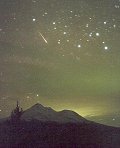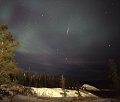|
Summary: Sky watchers who saw
it will never forget it: the 2001 Leonid meteor storm.
The display began
on Sunday morning, Nov. 18th, when Earth glided into a dust cloud shed by comet Tempel-Tuttle in 1766. Thousands
of meteors
per hour rained over North America and Hawaii. Then, on Monday
morning Nov. 19th (local time in Asia), it happened again: Earth
entered a second cometary debris cloud from Tempel-Tuttle. Thousands
more Leonids then fell over east Asian countries and Australia.
Page
1 | Page
2 | Page 3 | Page 4 | Page
5 | This is Page 6
All images
below are copyrighted by the photographers.
Some of the videos in this collection appear in RealPlayer
format.
|
|
Photographer, Location |
Images |
Comments |
 |
Michael Pique,
Learmonth Solar Observatory, near Exmouth, Western Australia
Nov. 19 |
#1 |
M. Pique: "The Southern Cross is behind
the bottom of the dish, with beta and alpha Centauri rising below.
The meteor crossed almost in front of the south celestial pole.
" |
 |
John Flinn,
Mt. Shasta, California, USA
Nov. 18 |
#1 |
J. Flinn: "The view of the Leonids with
Mt. Shasta as a backdrop was really spectacular. Sometimes as
many as 5 bright Leonids were in the sky at the same time. (Usually
in the opposite part of the sky I was aiming my camera). This
is one that did not get away." Photo details: Nikon FM2
with 35mm wide angle at F1.7 and 25 seconds exposure on Provia
400F film. |
 |
Mike Hutchinson,
Muncie, Indiana, USA
Nov. 18 |
#1,
#2, #3,
#4 |
This sequence shows the
ring-shaped debris from an exploding Leonid meteor. Photo details:
Kodak Royal Gold 400 color print film. 4 sec. exposures. Full-sized
frames: #1,
#2, #3,
#4 |
 |
Yuichi Takasaka,
Whitehorse, Yukon, Canada
Nov. 18 |
#1 |
Some sky watchers saw the Leonid storm and a
geomagnetic storm at the same time. This view of a Leonid streaking
through Northern Lights comes from the Canadian Yukon. |
 |
Wally Pacholka,
Joshua Tree National Park, near
Palm Springs, California, USA
Nov. 18 |
#1,
more |
This spectacular image, entitled "The Night
of the Falling Stars," is a composite of four one-minute
exposures. |
 |
Ed Majden,
Majden
Observatory, Courtenay, B.C. Canada
Nov. 18 |
#1 |
Ed Majden captured this spectrum of a Leonid
meteor, which reveals oxygen, magnesium, and sodium emissions
from the vicinity of the ablating meteoroid. [more
information] |
 |
Vesa Särkelä,
Kemijärvi Finland
Nov. 18 |
#1,
more |
The full-sized version of this image reveals
a Leonid streaking through bright auroras. Photo details: Fuji
Provia 400f, 45 sec, f 2.8 |
More images (click on the name of the photographer
to view the image):
Ronald Mochinski
(Mickie Gordon Park, Middleburg, VA);
back
to spaceweather.com |






